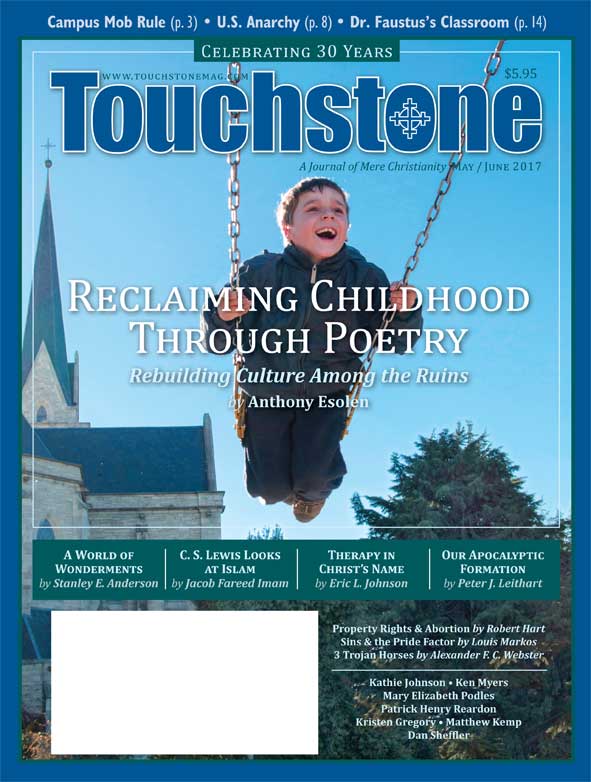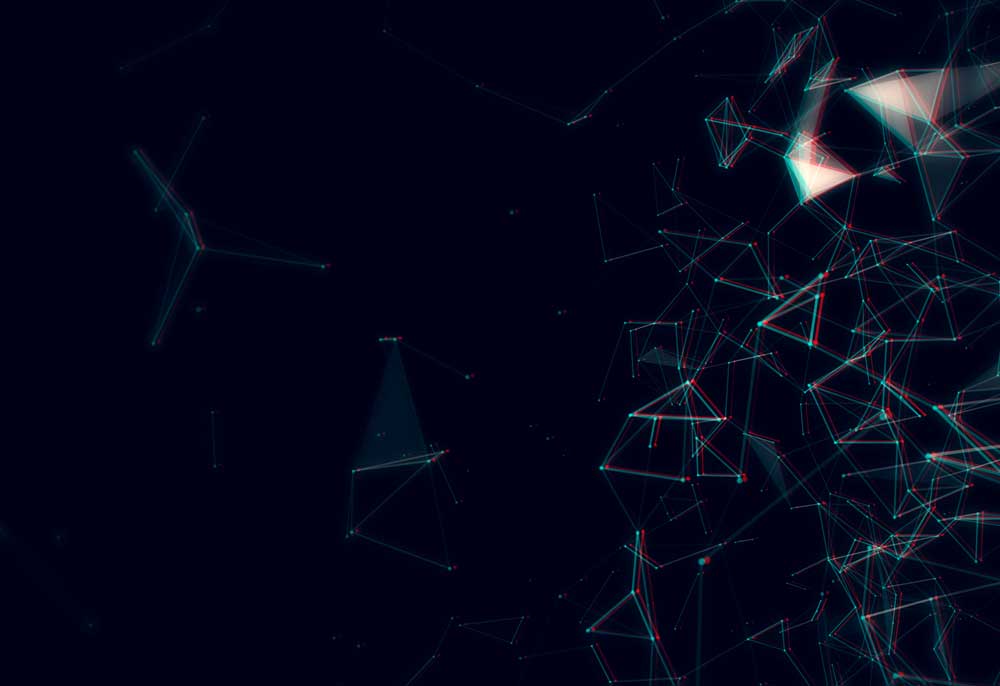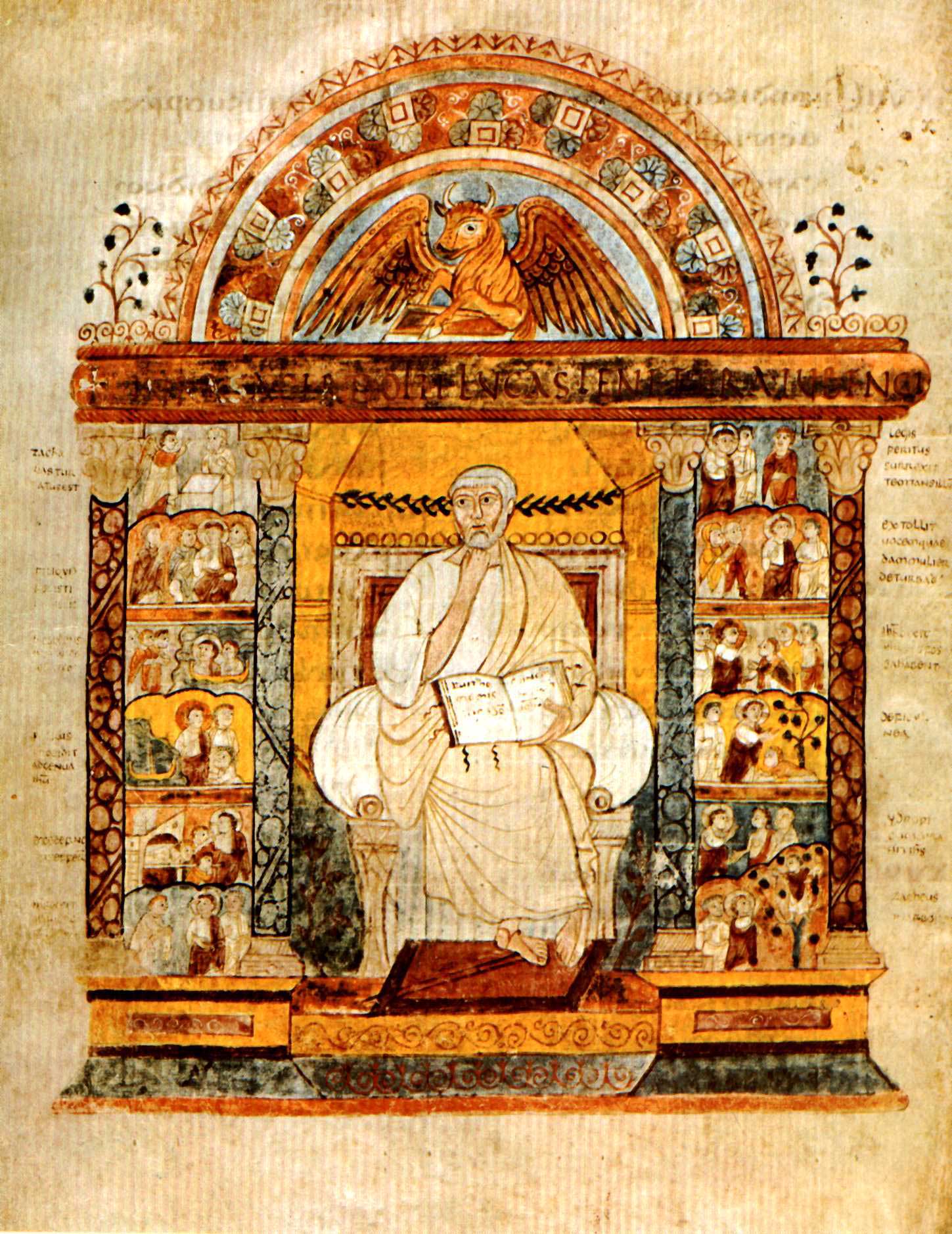Feature
Wonderments & Possibilia
An Invitation to Look Outside the Box of Materialism
Much debate about science and religion centers on their purported conflict, as though they were rival boxers at opposite corners of the ring, ready to come out punching and may the best man win. A dominant modern view holds that religion is down for the count and science the looming champion. Another view suggests that science and religion address entirely different issues, as though the boxers have arrived at different venues and are wondering where their opponent has got to. But I think the analogy of a boxer with his trainer better represents their proper relationship.
Let me illustrate this with a different analogy. Imagine a patient who claims to follow only the instructions printed on his prescribed bottle of pills. The last instruction on the label reads, "If symptoms persist for more than two weeks, consult a doctor." The symptoms do persist, but the patient does not call a doctor because, he insists, any outsider's advice, even the instruction-recommended doctor's, is not part of the actual instructions on the bottle. No amount of directing his attention to that sentence will sway him.
As a Catholic, I have used this illustration, which I call "sola prescriptura" in gentle ribbing of my Protestant friends, to suggest that, just as the bottle's label "points" to the doctor, so Scripture points to the Church as its proper interpreter. But here I intend it to use it to illustrate the problem with the materialist worldview, which says of the physical universe, "This is all there is." For like the prescription bottle, the universe seems to have labels that point pervasively "elsewhere." That pointing is summarized in the familiar opening of Psalm 19, "The heavens declare the glory of God; and the firmament sheweth his handywork."
An Explanation of Terms
In scientific and mathematical arenas, that pointing has two contrasting aspects that I call wonderments and possibilia. I have pressed the word wonderments into service to refer specifically to wonder-filled ideas rather than to wonder itself or to physical objects evoking wonder. The somewhat arcane and academic philosophical term possibilia retains its meaning of "possible things." Both are meant to illustrate the plight of compressive obstructionists, a term I first coined as a parody of the clinical term obsessive-compulsive, but that I use here to indicate key qualities of the materialists' worldview.
Though similar in purpose, wonderments and possibilia work from two different angles, one from above and the other from below, as it were. Wonderments are not unlike a puddle newly discovered by a child after a rain; with wide-open eyes, the child simply wanders into one with sudden delight and starts splashing about. An additional aspect of wonderments is that (unlike the puddle) they are often not discernable as concrete or clearly definable things. Nevertheless, the very quality of being difficult to conceive can be one of the elements of the wonder they evoke. Speculating what colors beyond the visible spectrum might look like if we could but see in that range has some of this enticing, incomprehensible quality. In any case, an inquisitive "Oh, what is that out there?" sense is a defining aspect of wonderments.
Possibilia, on the other hand, are like the opening line from Robert Frost's poem "Mending Wall": "Something there is that doesn't love a wall." They respond to, or "operate on" already existing philosophical barricades, tearing down what I call "impossibility fences." Imagine a master detective's pedestrian-minded companion who, upon examining a crime scene, confidently declares that the prime suspect could not possibly have murdered the victim. But the master detective, undeterred, immediately rattles off several different scenarios that readily admit the possibility of the suspect's involvement. The companion realizes his hasty error and retracts his premature conclusion. It is important to note here that none of the detective's hypothetical scenarios may in fact be correct. Their purpose as possibilia is only to demonstrate the potential existence of previously blocked and unexplored avenues.
Two "Aha!" experiences from my childhood may clarify the contrast between the terms and their purposes as I use them here.
At an early age, I was presented with this brain teaser: A grasshopper leaps one inch on its first jump, one-half inch on its second jump, one-quarter inch on its third jump, and so on, each consecutive jump being half the length of the previous one. How many jumps will it take the grasshopper to travel two inches?
I dutifully measured out with pencil, paper, and ruler each consecutive jump and arrived at an answer of seven jumps. As a check, I tried again and got eight jumps instead. Sharpening my pencil to a finer point, I tried again and got nine. What was happening here? I wondered. Suddenly, in a blinding rush of awe and excitement, I realized that the grasshopper would never make it to two inches—the answer was "infinity"! And not in the sense of "a whole bunch," as my more childlike mind had understood the word, but in the sense of truly being "without end."
Fifty years later, I can still recall the ecstasy I felt as I began to appreciate the delightful inscrutability of the concept of infinity. I could not picture infinity or fully understand it, but there was no doubt in my mind that it existed "out there," beyond my grasp. In fact, it was all the more tantalizing for existing so undeniably and yet being so utterly unreachable from the familiar reality around me. Yet it was my investigation of that familiar reality, in the form of a jumping grasshopper, that elicited the recognition that something was "out there" in the first place. That was an experience of wonderment.
The second "Aha!" moment occurred in my atheist-leaning teen years. The idea of God existing "outside" the universe seemed ridiculous to me by then. It was, I thought, an obvious contradiction, since the universe contained everything. At that age, I was also contemplating Artificial Intelligence (AI), the idea of a world with living, thinking creatures residing inside a computer program (this was long before movies like Tron or The Matrix).
At some point, I had another rush of insight: I suddenly realized that distance, time, and physical experience in the programmed world, the world of AI, would bear no direct relation to distance, time, and physical experience in the "real" world, the world I inhabited. What in the actual physical world, I asked myself, would correspond to an inch of distance or an hour of time or the sound of a hammer hitting a nail within the programmed world? Indeed, what could the idea of "within" even mean, physically? The size of the computer itself would not reflect sizes or times or experiences inside the programmed world. It would be, as mathematicians might say, incommensurate. A billion miles or years in the programmed world would seem no more vast or daunting to the programmer out here than, say, simply writing the digit 1 followed by nine 0s on a paper napkin.
This realization was humbling; I had to concede that the limits of possibility were perhaps not as limiting as I had previously imagined. My self-imposed wall of impossibility had been breached, and I could no longer rule out the idea of God being separate from the universe. Curiously, the breach had occurred from within the wall's own confines.
As with the wonderment of infinity, the possibilia of a breach in the universal wall did not reveal a clear picture of what exactly might be "out there." But there was fascination enough in the mere fact that there was now an exposed path in front of me where previously there had seemed to be a wall blocking the way.
To be sure, many examples may be hard to classify as exclusively "look out there" wonderments or "go through down here" possibilia. But the contrasting yet interlocked wholeness of both concepts provides a healthy integrity to their mutual pointing "out there."
Healthy spiritual growth exhibits this interlocked wholeness, too, by expanding good areas while clearing out bad ones, neglecting neither. Focusing on clearing out the bad while neglecting to expand the good can lead to the situation described by Jesus in Matthew 12: when an unclean spirit has gone out of a man and failed to find rest, he returns to the man's soul, and finding it "empty, swept, and garnished," he brings in seven even wickeder spirits, so that the last state of the man is worse than the first. Similarly, focusing on expanding the good while neglecting to clear out the bad can be like St. Paul's "little leaven" that is not good and that subsequently leavens the whole lump (1 Cor. 5:6f). Truly beneficial growth works in both directions simultaneously.
The CO's Perspective
Compressive obstructionists (or COs for short), on the other hand, seem to combat both wonderments and possibilia, especially when it may not be clear what the latter are pointing at, only that there must be something "out there" somewhere. Two books illustrate the two aspects of a CO's perspective.
First, obstructionism. In one of Robert Heinlein's science fiction novels, Orphans in the Sky (1963), a society has been living for generations in a gigantic, windowless, interstellar spaceship. With the passing of the generations, the ship's inhabitants come to forget that there is space outside their ship and think that the ship is the entire universe. Even though the ship's outer walls would seem by their very existence to declare, "I am blocking anything 'out there' from being seen," the inhabitants simply can't imagine anything existing beyond those walls. In other words, they no longer see the wall as a wall. This illustrates the obstructionist half of the modern materialist worldview.
Second, compressiveness. Erich von Däniken's non-fiction book Chariots of the Gods (1968) posits that "ancient astronauts" visiting earth were responsible for seemingly unexplained artifacts and the rise of various technologies and religions. An expansion of this idea is that life itself arose on earth because ancient astronauts "planted" it here during their visits in the distant past. The obvious response to these speculations is, "So what?" We simply back up one step and ask how life arose on the ancient astronauts' planet instead. If the answer is, "Even older ancient astronauts," then the game should be up, since the explainers have conjured an infinite regress.
But what if they revert to a child's idea of "infinity," meaning simply "a whole bunch," and consider the question closed? Now they are simply refusing to look for an answer. This illustrates the compressive half of their worldview.
In sum, whereas the tag lines of individuals open to wonderments and possibilia might be "Oh, what is that out there?" and "Hmm, I guess I never thought about that before," the tag lines of COs might be "Humph! This is all there is" and "Shh, don't go there."
The attitudes exemplified in both books may seem trivial and foolish, yet a great many people, religious or atheist, laymen or scientists, regularly embrace them without realizing it. The history of science and mathematics contains numerous examples of individuals exhibiting the "don't go there" attitudes and "circling the wagons" tendencies of COs. Ironically, they often do so in the very act of encountering wonderments and possibilia.
Examples from Mathematics
Need some examples? Here are some, but I offer them with a certain reluctance, lest they seem to suggest that a firm, even gnostic, understanding of complex and technical ideas is required. Psalm 19 implies that our -common gifts of wonder and praise and gratitude are sufficient to recognize God's glory and handiwork as shown and declared to us by the heavens. Unfortunately, the post-Enlightenment worldview, with its ever-increasing emphasis on blanket materialist assumptions, has been effective in obscuring such recognition, leading many to unquestioning acceptance of the mantra, "This is all there is, I know, for the Science tells me so." The examples presented here reveal only one of many paths out of the materialist jungle, but their lesson can be applied even in the day-to-day jungle of worldly struggle.
Irrational Numbers: Let's begin with an early mathematical example: the dismayed discovery by the ancient Greek Pythagoreans that it is impossible to represent as a fraction a very common and accessible number, the square root of two (often pictured as a diagonal drawn across a unit square). A very simple proof handily dismantled the conceptual wall that blocked from view the existence of non-fractional numbers (or irrational numbers, as they are called). This very neat and tidy example of possibilia was so disturbing to the Pythagoreans that they apparently tried to hide the conclusion, and there are hints that they might even have attempted murder to conceal the uncomfortable fact. Their dramatic reaction exposes the obstructionist half of the CO mindset.
There are two fascinating aspects of the proof: first, it gives not the slightest hint about the size of the square root of two. It might be larger than a trillion or less than one. Nor does the proof say anything about the type of number it might be, aside from the fact that it is not a fraction. It is as if a witness to a crime were asked by the police to describe the criminal and he said, "Well, he didn't look like a toaster." Second, the proof effects its conclusion using only arithmetic facts already common to whole numbers and fractions. The irrational numbers did not suddenly poke their heads in the door and say, "Hi! We were just passing by and thought we'd drop in for a visit."
Non-Euclidean Geometries: A similar approach that yielded a different, but equally baffling result for mathematicians in the nineteenth century was the discovery of non-Euclidean geometry. Euclid's famous parallel postulate says that only one line in a plane can be parallel to another line a fixed distance away. This seemed perfectly obvious, but it also seemed too "messy" to be a postulate—that is, mathematicians thought it should be provable using the simpler postulates. Attempts to prove that more than one parallel line existed should quickly yield a contradiction, they thought, thus proving the postulate true. Many crazy-sounding theorems arose in the search for the proof, but never the expected contradiction. Finally, in exasperation, some mathematicians proposed a new kind of geometry that embraced the assumption that more than one parallel line was possible—and, for good measure, some proposed a system assuming that no parallel lines are possible. These new systems were referred to as "non-Euclidean" geometries, a name likewise effectively declaring, "not a toaster."
These geometries were indeed wild and wooly things, but in 1868 they were proven to be as logically consistent as Euclidean geometry. And like the irrational number proof, their exposition relied only on logical manipulations already long used in standard Euclidean geometry. Moreover, the "curved space" of non-Euclidean geometry was instrumental in Einstein's General Theory of Relativity. But the original development of these geometries, in typical possibilia fashion, didn't say how they could possibly be, only that they could be without logical contradiction.
Imaginary Numbers: A third mathematical example involves the seemingly impossible-to-imagine square root of a negative number. Multiplying any number, positive or negative, by itself always results in a positive number. And yet equations arose where positing the square root of negative one (never mind what it might be) allowed otherwise intractable mathematical problems to be solved relatively easily. The square root of negative one as an abstract placeholder would pop up unexpectedly, like a superhero, to solve the problem, and then disappear back into its secret identity "out there," leaving no trace of its trespass into the "real" world. The name given to numbers incorporating the square root of negative one, "imaginary," was originally meant derisively—perhaps reflecting the compressive half of a CO's thinking—but their development into Complex Analysis would be a game-changer in real-world applications.
All these examples had an initial "But what is it?" or "Where is it?" or "How can it possibly be?" quality. At first, they pointed "out there" as enticing wonderments or impossibility-fence-dismantling possibilia, but eventually they became accepted mathematical concepts. And with that acceptance, they often were incorporated into the "this" of the CO mantra, "This is all there is." It's as though the walls of the spaceship in Orphans in the Sky were stretched, allowing more things to fit inside, but they still remained opaque, blocking the view of yet more things "out there."
Examples from Physics
Numerous examples from physics could be cited as well. One has to do with Newton's laws of gravitation. On the surface, these laws seem to be a counter-example of something pointing "out there." They declare the motions of the ineffable heavenly bodies "out there" to be subject to the same "everyday" gravity that earthly bodies "down here" obey. Nevertheless, Newtonian physics left a wonderment-filled void of "action at a distance" gravity (the concept that an object can be moved or changed without being touched by another object) operating even at interplanetary distances and beyond. One could choose either to wonder at this or to compressively consign it to inattention.
Likewise, Einstein's theory of Special Relativity, with its fantastically unbreakable and absolute speed of light, which permeates all of space-time, is a wonderment that is often compressively ignored as the absolute elephant in the otherwise all-things-relative living room.
The world of quantum physics is awash in wonderments and possibilia. But it has not been without firm efforts at wonder-suppression, too. For instance, Einstein and Niels Bohr for years engaged in friendly debate over the "spooky action at a distance" of quantum entanglement, yet both men managed to assume a priori a "this is all there is" view of the world in their contrasting defenses.
The quantum wave function posits, before observation, a "superposition of states" where, enticingly, "all things are possible." But quantum experiments show that our observations "collapse" the wave function into the single state of the "real" world around us. One could regard the superposition of states as an even higher level of "reality" than the particular collapsed state we see, but Bohr says that before an observation is made, the superposition of states is strictly statistical information and does not exist in any "real" sense. Einstein's objection also hinges on the view that the only "reality"—ironically referred to as the "collapse" of the quantum wave function—is the physical world we see before us. In this sense, their debate is reminiscent of a scene from the movie Stand By Me, where one character asks, "Do you think Mighty Mouse could beat up Superman?" and another answers, "Boy, you don't know nothing! Mighty Mouse is a cartoon."
Even Hugh Everett's "many-worlds" interpretation of quantum physics (or at least a popular view of it) falls victim to the "this is all there is" assumption. With a kind of universal hubris, this interpretation deconstructs the problem of the quantum wave function into a "whole extra-big bunch" of slightly different versions of the world we already see around us. It is a "this is all there is" worldview to the googolplex power, if you will, exemplifying the compressive subversion of the "how can it possibly be?" aspect of things "out there."
But the "out there" pointings of wonderments and possibilia do not simply make extra room for "more of the same"; they also reveal "otherness" and the possibility of a grander fullness. A three-dimensional cube is not just a stack of two-dimensional square sheets of paper that can be scattered onto the floor by a strong breeze; it has a solidity that a flat sheet of paper cannot have, no matter how large the sheet or how many duplicates are added to the stack. In contrast, the "many tongues" of Christ's apostles in the Book of Acts astounded the crowd at Pentecost, for each person was able to understand the words spoken in his own native language, a wonderment of grander fullness indeed.
Going back to mathematics, there were hopes in the early twentieth century for the articulation of a complete, formal mathematical system that could, in principle, prove the truth of any true statement. These hopes were dashed by Kurt Gödel's famous Incompleteness Theorems, which proved that there are mathematical statements which are true but which cannot be proved true. Again, Gödel's theorems said nothing about which particular true statements might be un-provable. Even more tantalizing than a youthful reaction to an unreachable infinity, this proof about the mathematical process itself is like infinity on steroids.
Jabs in the Armor
In his essay "Transposition," C. S. Lewis writes,
You will have noticed that most dogs cannot understand pointing. You point to a bit of food on the floor; the dog, instead of looking at the floor, sniffs at your finger. A finger is a finger to him, and that is all. His world is all fact and no meaning.
The materialist is perhaps not quite as ignorant of the heavens' persistent pointing as is a dog of its master's. Nevertheless, he firmly resists when anything points "out there" away from the material world. As we have seen, numerous results of scientific and mathematical research point outward and say, "Don't look down here at us—we are not all there is—look out there!" But the compressive obstructionist tendency is to bend the pointing fingers around to point back at themselves, subsuming them into materialist fodder.
Here is revealed a very curious facet of the universe. It seems that no matter how assiduously one bends back each pointer encountered, new ones always keep popping up around the corner, whispering, "Pssst! Over here—take a look." That nudge is inevitably followed by a piercing jab into the cracks of the materialist armor. Curiously, these jabs do not come from "out there," as if made by invading aliens from outer space; rather, they hail from the materialist's armor itself—and ironically, the thicker the armor, the sharper the jab.
Typically they offer insistent and demonstrable proofs that something "out there" must exist, while providing no clue about what or where that something might be or how it could possibly exist. The "otherness" being pointed at by the otherwise seemingly materialist world simply cannot be expressed in existing materialist terms except negatively—as in, "not like a toaster."
Thus, the examples cited here are not offered as any kind of proof of God's existence on the order of the many historical, philosophical, and theological treatises that seek to establish New Proofs for the Existence of God, as the title of Robert J. Spitzer's recent book has it. As interesting and insightful as such proofs might be, in the end, it is God himself who reaches out with his own unexpected and varied methods of revelation to beckon us into knowledge of him and acceptance of his love.
What these "internal" examples do suggest is that we are being prodded to retain an ever-vigilant outlook and to never be content with a "this is all there is" understanding of the world around us. If we heed those prompts—if we see puddles after a rain not as wearying impediments to avoid but as places to splash about in with joy and praise, if we notice chinks in the wall not as defects to be patched up but as peepholes opening upon new vistas—we will be better oriented to witness and acknowledge God's revelation when it comes.
Though fallen, the world seems conditioned to manifest those pointers no matter in what direction its fallen creatures turn. And God seems to bestow a grace to keep us from completely ignoring them. Whether that grace has an ultimate expiration date should be a sobering consideration for any compressive obstructionist. If the boxer-with-trainer analogy mentioned at the beginning has value here, the scientist will wisely use those pointers to engage in a kind of shadowboxing as preparation for meeting the real opponent rather than trying to beat his trainer into pulp. He may even discover that the source casting the shadow is himself.
Abounding Proclamation
All of us, not just scientists, are inclined to be COs by the very nature of our fallen status. I have taken my examples from science and mathematics because scientific advancement has so diverted our attention away from our natural dependence on our heavenly Father. As (per Aristotle) nature abhors a vacuum, so our souls abhor a lack of dependence on something, anything. We were created to delight in our dependence on God. If we deny that dependence, the void will be filled, but with the gnostic, technical authority touted by science.
But as Psalm 19 proclaims, wonderments and possibilia blossom in common and beautiful and varied ways all about and above us; it only remains for us to be open to their proclamation. We must not be content with mere consumption, but must strive to look "out there" and see that "this is not all there is." Scripture abounds with this message, from God's warnings to his people in the Old Testament that he is beyond the sacrifices they offer him instead of contrite hearts, to Christ's admonition to his followers in the Gospels, "Very truly I tell you, you are looking for me, not because you saw the signs I performed but because you ate the loaves and had your fill" (John 6:26). Only when the loaves become the wonderment of his Body will we have true fulfillment.
Even the Lord's Prayer, which petitions our Father to manifest his kingdom and to have his will be done here "on earth as it is in heaven," conveys unfathomable otherness: the two-dimensionality suggested by "on earth" is contrasted with the infinitely spacious three-dimensional fullness implied by "in heaven." This is a reversal of the compressive obstructionist nature of the many worlds interpretation, which seeks to make only "more of the same." That something of the otherness and glory of the heavenly fullness can be manifested in our flattened and fallen firmament is one of the sublime and enticing mysteries of God's handiwork. We who pray his words with hopeful anticipation and serious and fervent intent will someday see the true reality face to face.
Stanley E. Anderson holds a degree in mathematics and has worked in data analysis, IT, and quality assurance in the aerospace industry. He and his wife are converts from Anglicanism to the Catholic Church.
subscription options
Order
Print/Online Subscription

Get six issues (one year) of Touchstone PLUS full online access including pdf downloads for only $39.95. That's only $3.34 per month!
Order
Online Only
Subscription

Get a one-year full-access subscription to the Touchstone online archives for only $19.95. That's only $1.66 per month!
bulk subscriptions
Order Touchstone subscriptions in bulk and save $10 per sub! Each subscription includes 6 issues of Touchstone plus full online access to touchstonemag.com—including archives, videos, and pdf downloads of recent issues for only $29.95 each! Great for churches or study groups.
Transactions will be processed on a secure server.
more on science from the online archives
more from the online archives
calling all readers
Please Donate
"There are magazines worth reading but few worth saving . . . Touchstone is just such a magazine."
—Alice von Hildebrand
"Here we do not concede one square millimeter of territory to falsehood, folly, contemporary sentimentality, or fashion. We speak the truth, and let God be our judge. . . . Touchstone is the one committedly Christian conservative journal."
—Anthony Esolen, Touchstone senior editor













